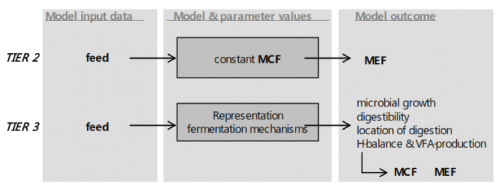Keywords: methane conversion factor | modeling | dairy cattle
What data needs were addressed? More accurate estimation of methane emissions from dairy cattle.
Why was the data needed? To account for high nutritional quality of dairy rations in The Netherlands.
Methods used: Prediction of the CH4 conversion factor from feed intake and dietary characteristics, using a dynamic model.
How was the data need addressed? Until 2005, The Netherlands used a Tier 2 approach to estimate methane emissions from mature dairy cattle. However, with high quality (and thus digestibility) of dairy rations, it was suspected the IPCC default value was too high. Furthermore, the constant default factor did not reflect variation in the level of feed intake, digestibility, composition and quality of the ration. Thus, the methodology was improved by adopting a country-specific Tier 3 approach.

Source: Bannink 2011
The approach is built on a model, originally developed for modeling rumen processes in dairy cattle. The model predicts methane production as a result of the microbial fermentation process in the gastrointestinal tract of dairy cattle. The model appeared suitable for modeling methane emissions as well by taking more detailed ration composition and quality into account.
Instead of using a constant country-specific emission factor, the model predics the methane conversion factor based on feed intake, ration composition, nutrient content and quality. The model represents the mechanisms for microbial degradation of feed particles. Using volatile fatty acids as end-product of rumen fermentation, methane emissions can be estimated.
The emission factor, gross energy and methane conversion factor are calculated annually.
Further Resources
The Netherlands’ NIR 2018.
Bannink A, van Schijndel MW, Dijkstra J. 2011. A Model of Enteric Fermentation in Dairy Cows to Estimate Methane Emission for the Dutch National Inventory Report Using the IPCC Tier 3 Approach. Animal Feed Science and Technology, 166-167, 603-618.
Vonk J, van der Sluis SM, Bannink A, van Bruggen C, et al. 2018. Methodology for estimating emissions from agriculture in the Netherlands update 2018. Calculations of CH4, NH3, N2O, NOx, PM10, PM2.5 and CO2 with the National Emission Model for Agriculture (NEMA).
Wageningen, The Statutory Research Tasks Unit for Nature and the Environment (WOT Natuur & Milieu). WOT-technical report.
Author: Andreas Wilkes, Values for development Ltd (2019)

